Perfectly cooked spaghetti is tossed together in a simple sauce full of lots of fresh black pepper and salty pecorino romano cheese to make this unbelievably good authentic Cacio e Pepe Recipe that dates back to Roman times! Made with just 3 basic ingredients this quick and easy Italian dish comes together in just 20 minutes making it a fantastic weeknight dinner that is both impressive and delicious!
What is Cacio e Pepe?
This classic pasta dish is a well-known Roman recipe that has been around for centuries. It’s a very simple 3-ingredient pasta traditionally made with dried spaghetti, pecorino cheese, and black peppercorns. Together these basic ingredients with a bit of the pasta cooking water create a fabulous pasta that is super peppery, cheesy, and coated in a creamy light sauce. In many ways, cacio e pepe is very similar to other Roman classics like carbonara and pasta alla gricia.
As for its history, Cacio e pepe is said to have its roots in transhumant shepherding back in Roman times when shepherds had to make long journeys with their flocks. They would fill their saddlebags with long-lasting simple ingredients like aged cheese, dried pasta, and black peppercorns, which is how this loved Roman recipe was born. And another perfect example of why Italian cuisine is known for taking just a few ingredients and turning them into dishes that are easy to make and incredibly delicious.
What do you need to make this recipe?
Equipment:
- Large Pot – Used to cook the spaghetti.
- Colander – Makes it easy to drain the pasta.
- Saute Pan – Needed to toast the ground black pepper and finish the dish. The pan needs to be large enough to comfortably fit all the cooked pasta.
- Grater – This tool is needed to freshly grate the pecorino cheese.
- Mortar and Pestle – Used to grind the whole black peppercorns.
What ingredients do you need to make this recipe?
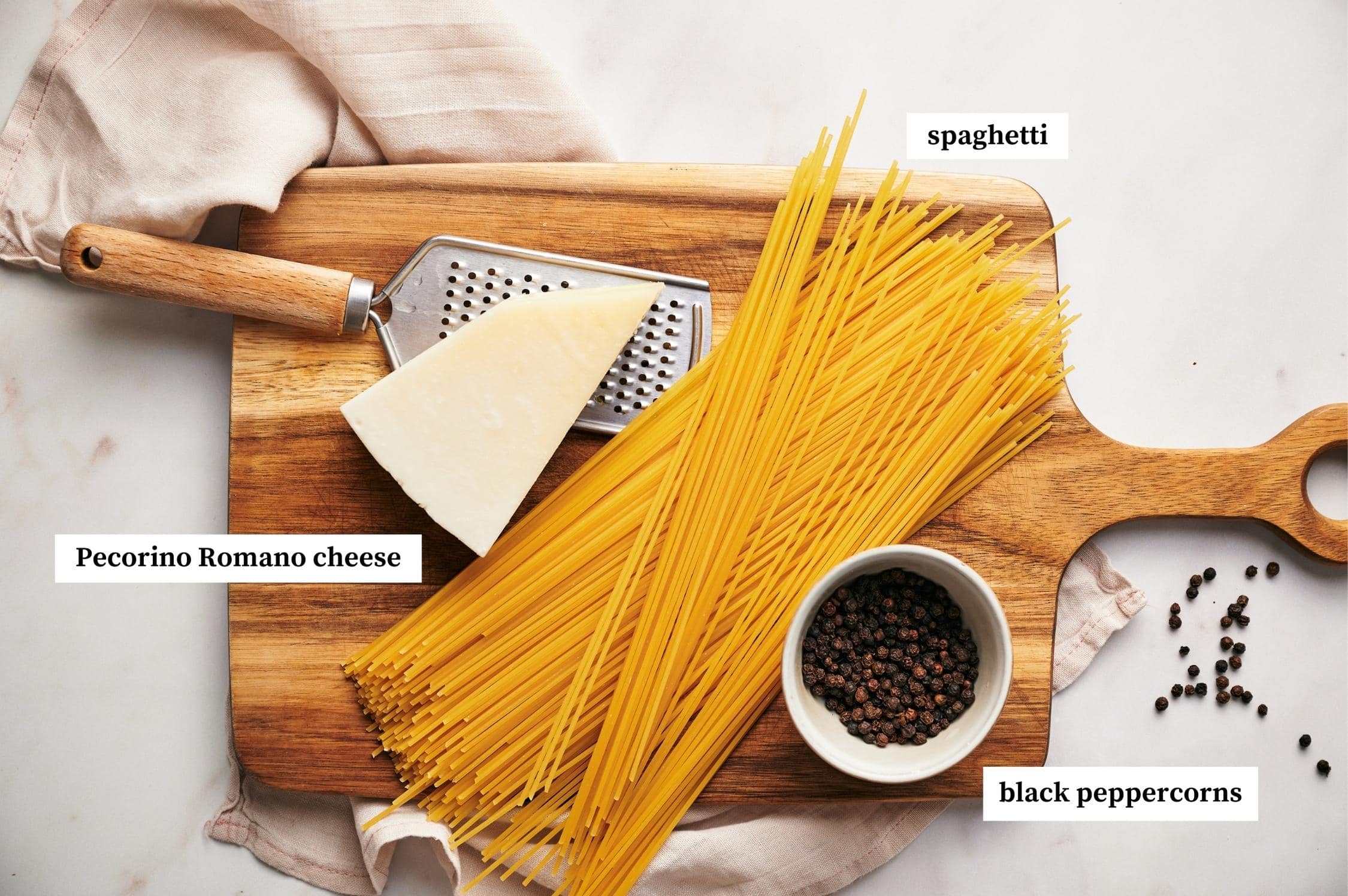
- Spaghetti – This simple dish is traditionally made with dry spaghetti. Never use fresh noodles. However, you will see tonnarelli, rigatoni, or even egg pasta used to make cacio e pepe. But egg pasta and tonnarelli tend to be too porous, so for the perfect pasta always use spaghetti.
- Black Peppercorns – Whole black peppercorns are an important traditional ingredient in this pasta. You can also freshly ground black pepper too. Yet, regular store-bought ground black pepper will not work very well.
- Pecorino Romano Cheese – For the most authentic taste, freshly grated Pecorino Romano cheese. However, in a pinch, Parmigiano Reggiano is another good Italian cheese you can use. Also, pre-grated cheese does work but the sauce won’t turn out as creamy.
- Pasta Cooking Water – You need to reserve some of the pasta cooking water to finish the dish and make the sauce.
- Salt – Used to season the pasta cooking water.
How to make this recipe step-by-step
Cook the spaghetti
The first step is to start cooking the pasta. Bring a large pot of water to a boil with about a tablespoon of salt. Next, add the dry spaghetti to the boiling water (photo 1) and cook it just until it’s slightly underdone, right before it reaches al dente. Now, set aside 4 cups of the pasta cooking water and then use a colander to drain the noodles of the excess water.
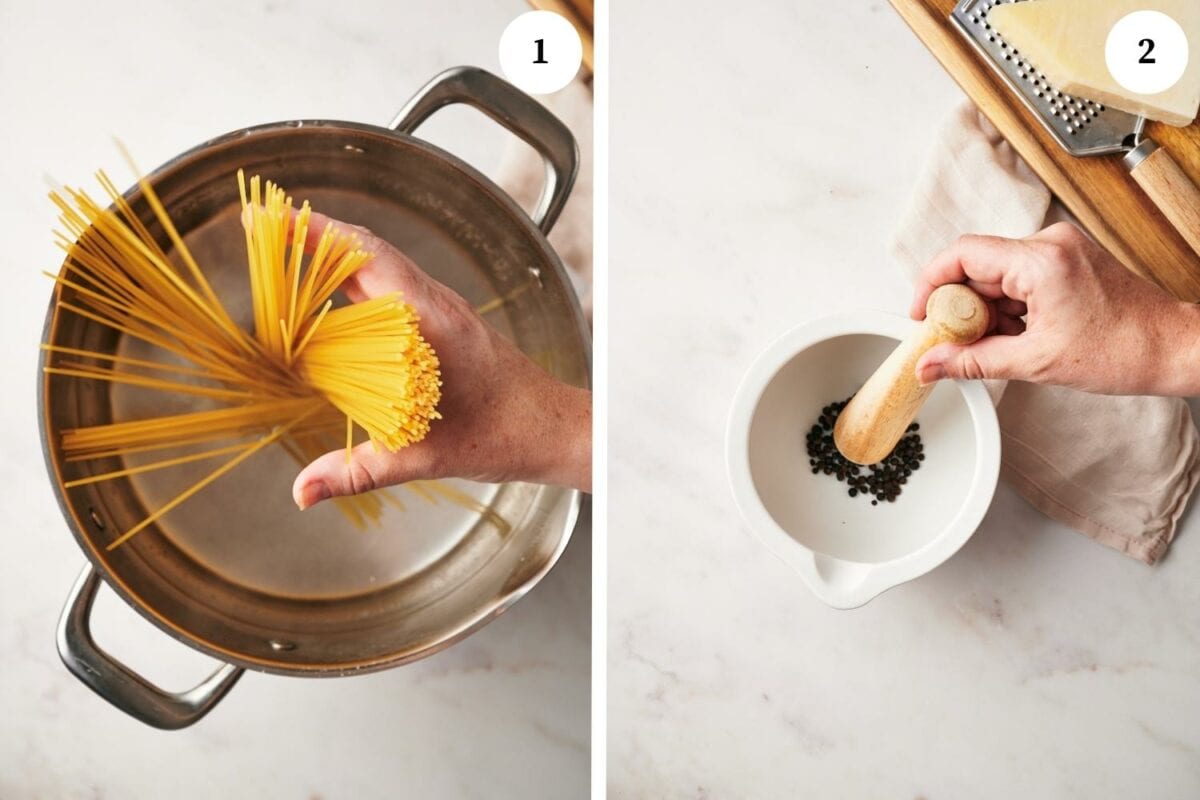
Grind the peppercorns
While the pasta is cooking, use a mortar and pestle to grind the whole black peppercorns (photo 2). You want the ground pepper to be all different sizes of chunks. They should not be uniform. You can also use freshly ground pepper if you don’t have a mortar and pestle.
Make the pecorino paste
To make the paste, just mix 1 tablespoon of lukewarm water together with the grated pecorino Romano cheese in a medium bowl (photo 3). This step helps to prevent the sauce from having a grainy texture.
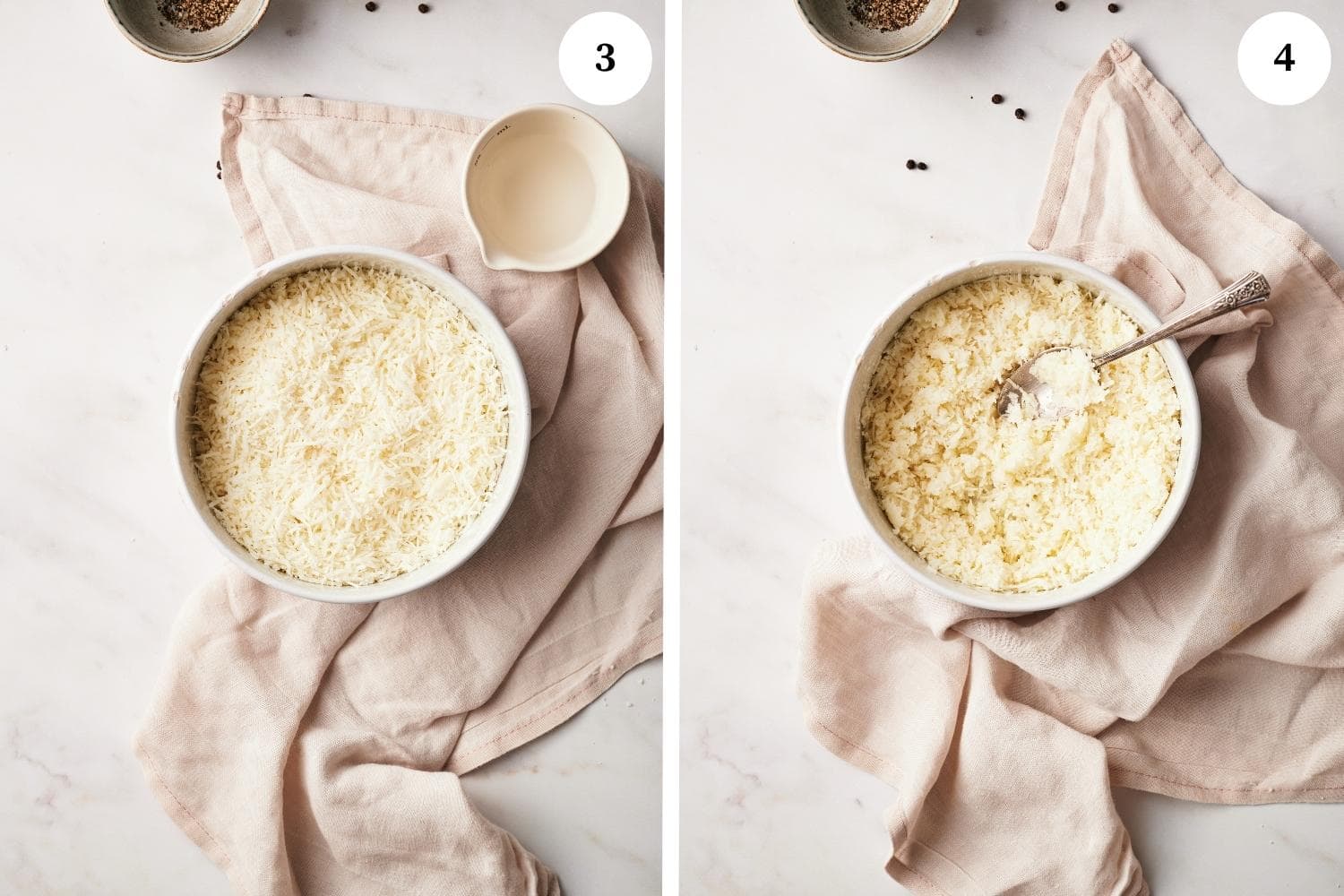
Toast the peppercorns
Heat a dry large pan over medium-high heat. Then add the freshly ground black pepper and toast it for 30 seconds. Next, add 1 cup of pasta water to the pan and then let the pepper mixture simmer over high heat for 2 minutes (photo 5).
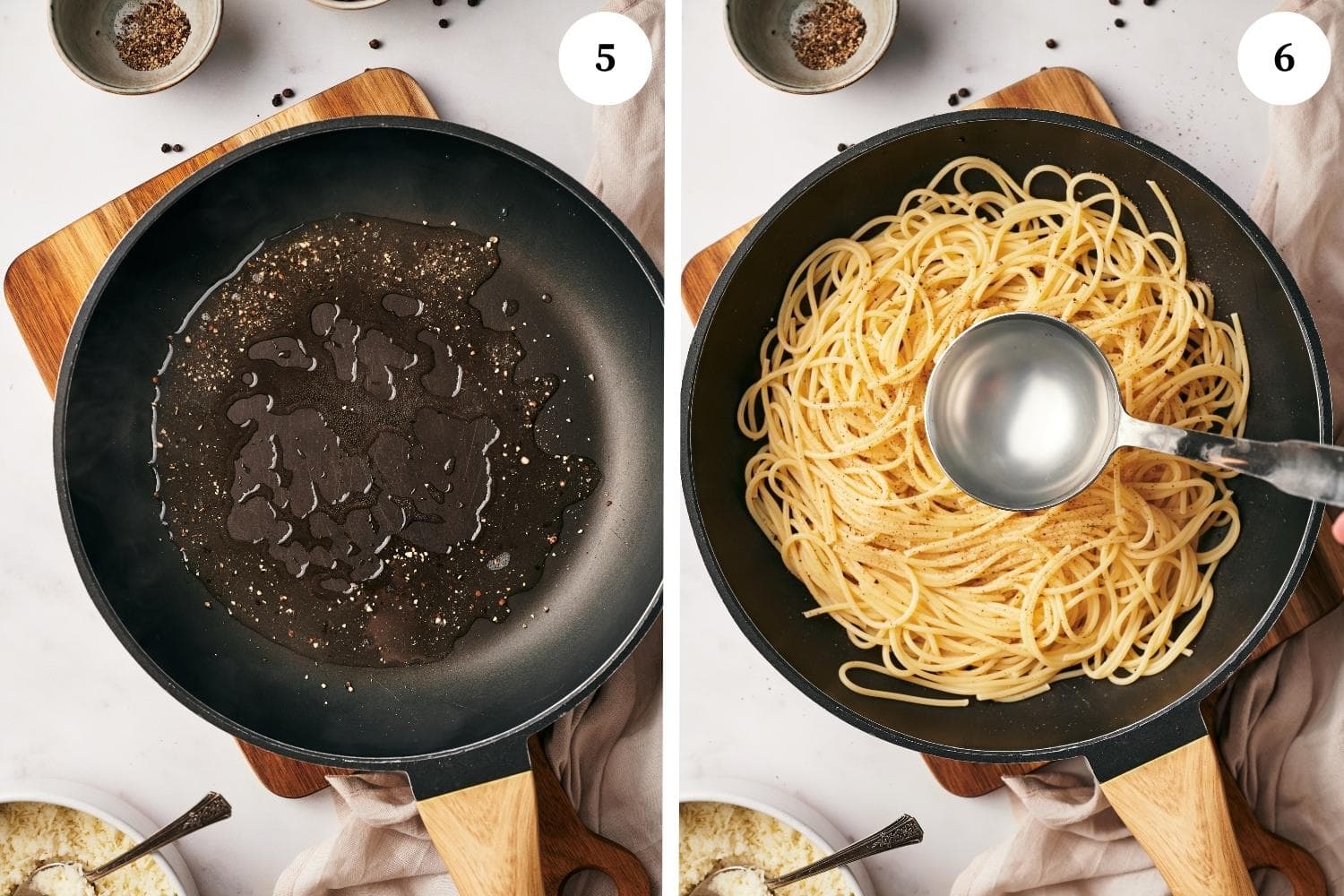
Add the pasta
When the spaghetti is done, add the noodles to the large saute pan with the black pepper water. Then add more of the pasta water to the pan to finish cooking the noodles (photo 6). It’s better to add a little of the water at a time rather than dump too much in the pan. When the noodles are done they should be creamy and al dente.
Finish the dish
Here is where all the elements of this simple recipe come together! To begin, turn the heat off immediately once the spaghetti is fully cooked. Now, add the pecorino Romano paste to the hot noodles (photo 7) and then toss everything together well until a creamy sauce forms. If the pasta is too dry all you need to do is add a bit more of the reserved starchy water.
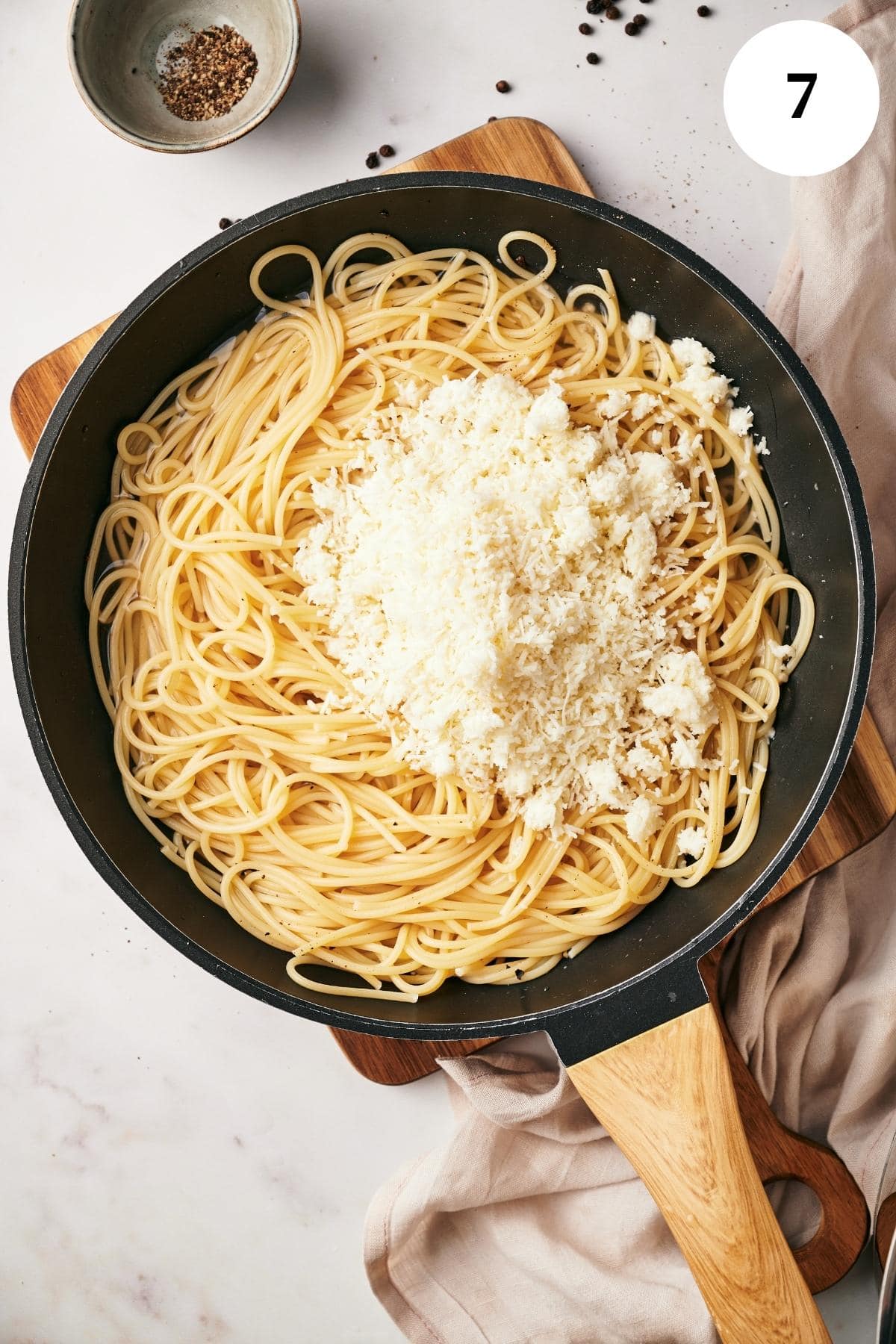
Season and serve
Once the cacio e pepe pasta is ready, garnish with some more pecorino cheese and freshly ground black pepper. Then serve it with your favorite wine and salad.
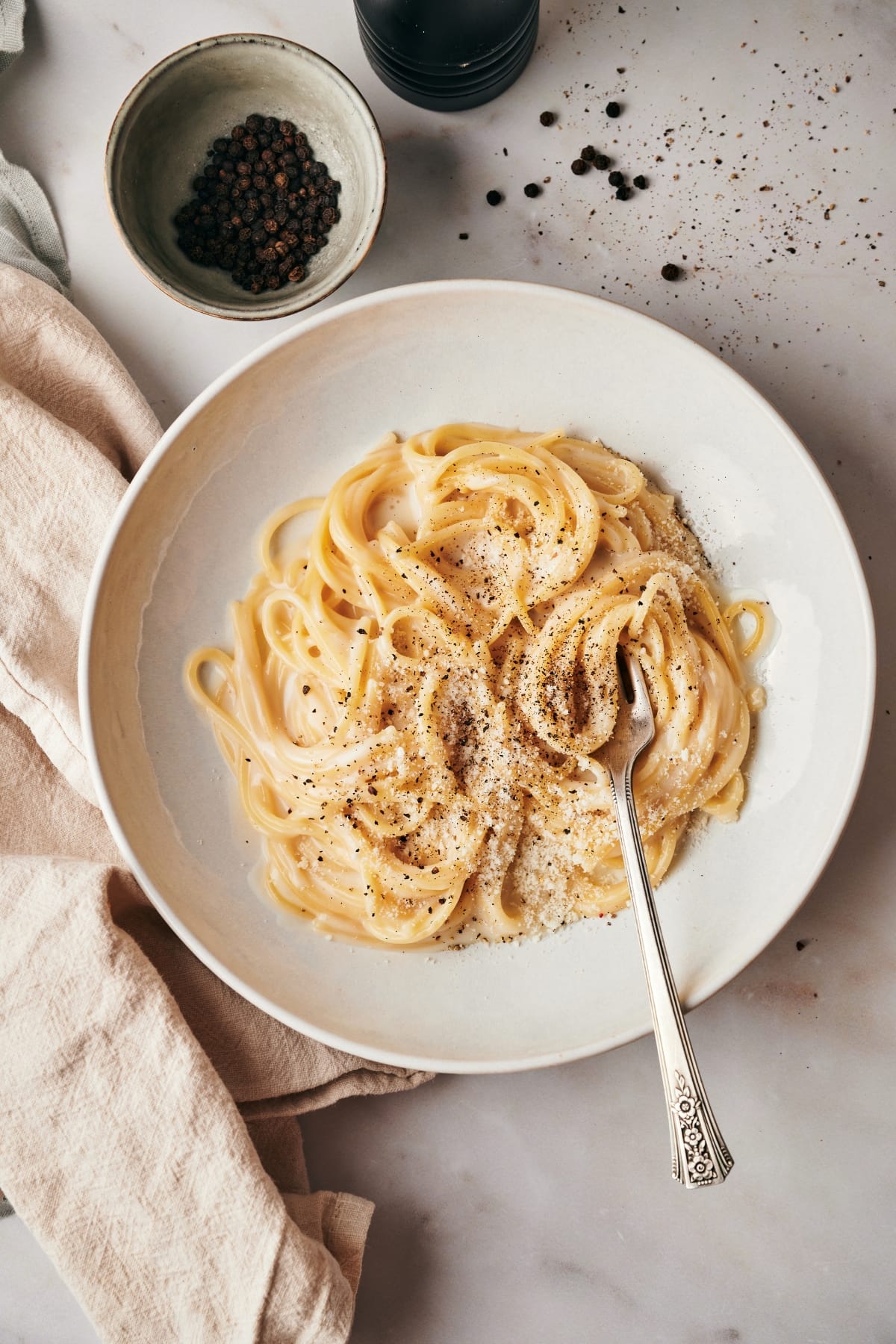
Expert Tips
- Make sure to salt the pasta cooking water well to season both the noodles and the sauce.
- You must reserve some of the pasta water to finish cooking the spaghetti and make the sauce.
- It’s crucial that you do not fully cook the spaghetti when it’s first boiled. It must be slightly undercooked and will finish cooking in a later step.
- It’s important to mix the pecorino cheese with a bit of lukewarm water to make the paste. Do not use hot water. This ensures that your sauce will be smooth.
- In recipes with fewer ingredients, quality matters more. So for the most authentic flavor, use whole black peppercorns and grind them yourself. Also, use high-quality Pecorino Romano cheese.
- Turn the heat off immediately once the spaghetti is done cooking in the saute pan. Then add the pecorino paste and finish the dish. If you don’t, the noodles will overcook.
Other traditional Roman recipes for you to try:
- Pasta alla Gricia
- Authentic Italian Pasta Carbonara
- Bucatini all’ Amatriciana Sauce Recipe
- Penne alla Vodka
- Gnocchi alla Romana
FAQs
What does cacio e pepe mean in Italian?
It literally translates to “cheese and pepper” in Italian.
Can I use Parmesan instead of pecorino for cacio e pepe?
Of course, you can! It’s traditionally made with pecorino but a good quality fresh grated Parmesan cheese will work just as well. The flavor will just be a little less authentic.
Why does the cheese in my cacio e pepe clump?
If you just toss the grated cheese into the dish it will likely clump. This is why it’s so important to make a paste with pecorino cheese and pasta water before adding it to the cooked noodles. Turning the cheese into a creamy paste helps to prevent it from clumping.
Is cacio e pepe similar to carbonara?
The two dishes are both classics and do have similarities such as they both have pasta, pecorino Romano cheese, pasta water, and black pepper in their ingredient list. However, they are very different in other ways. Because those ingredients are all you need to make cacio e pepe, but to make carbonara you also need egg yolks and cured pork which make it a very different dish.
How to store pasta cacio e pepe?
Leftovers will keep for up to 4 days in the fridge when stored in an airtight container. To reheat, sprinkle the pasta with a bit of water to add a little moisture and then put it in the microwave for a few minutes on medium power. You can also reheat it on the stovetop over medium heat. This dish does not freeze well.
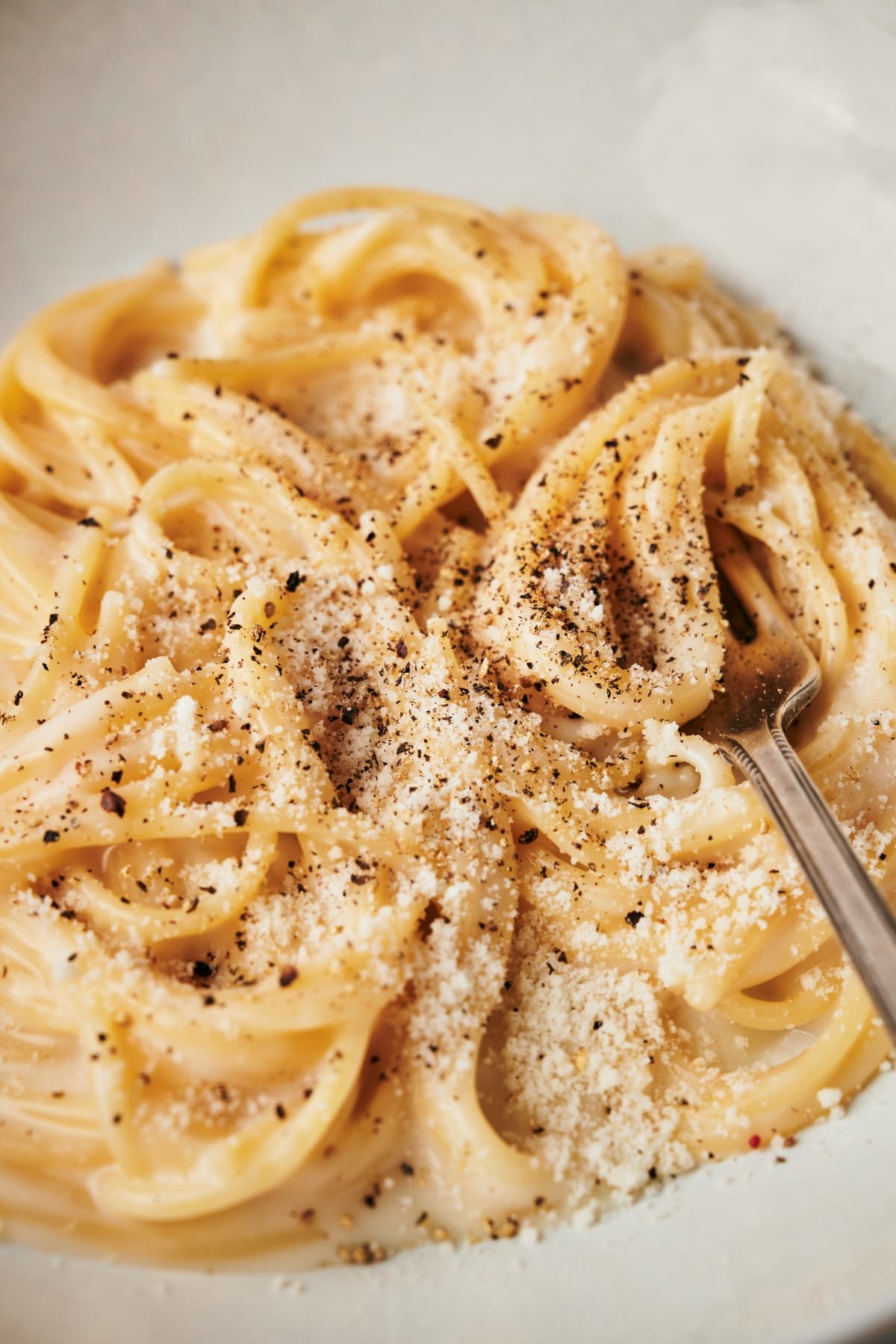
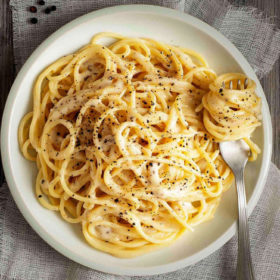
Pasta cacio e pepe
Ingredients
- 320 grams spaghetti
- 1 tablespoon whole black peppercorns 1 to 2 tablespoons
- 200 grams Pecorino Romano grated a little more for serving
Instructions
-
Bring a large pot of salted water to a boil. Then add the pasta and cook it until it’s a little undercooked or very al dente. When it’s done, reserve 4 cups of the starchy pasta cooking water and then drain the pasta.
-
As the pasta is cooking, grind the whole peppercorns with a mortar and pestle. You can also use freshly ground black pepper if you prefer.
-
Put the freshly grated pecorino cheese into a medium bowl. Then stir in 1 tablespoon of lukewarm water. This helps to prevent a grainy cheese sauce.
-
Toast the ground black pepper in a large pan over medium-high heat for just 30 seconds. Then add 1 ladle of pasta water and let the mixture boil for 2 minutes.
-
Put the slightly undercooked pasta in the pan with the pepper water. Then add just enough of the reserved pasta water to continue cooking the spaghetti a little more. If needed, keep adding more cooking water until the noodles are creamy and perfectly al dente.
-
Turn the heat off the moment the pasta is done and creamy. Now, stir in the pecorino paste and toss it together well with the spaghetti. At this point, if the pasta seems too dry just add more of the reserved cooking water.
-
Serve the cacio e pepe with a bit more freshly ground black pepper and grated pecorino cheese.





